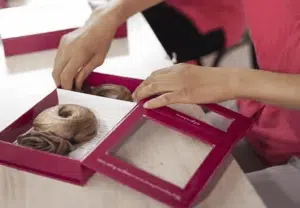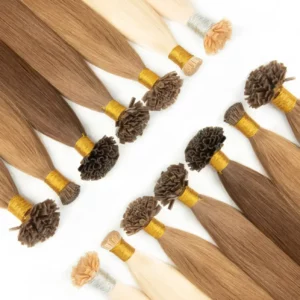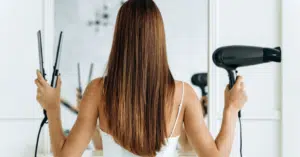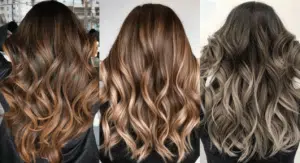We’ve all had that client call the next day after their install:
“These beads are pulling. I couldn’t sleep!”
Sound familiar?
Beaded extensions—like I-tip, nano tip, or beaded wefts—offer lightweight, long-lasting results. But if clients don’t protect their hair at night, those benefits can turn into bead tension, matting, and early slippage. And for salons, that means more redo appointments and frustrated clients.
In this guide, you’ll get everything U need to teach clients how to sleep with beaded extensions the right way—while also preserving the lifespan of their install and the integrity of the hair.
To sleep with beaded extensions, ensure the hair is 100% dry, gently detangled, and secured in a loose braid or ponytail. Use a silk or satin pillowcase or bonnet to reduce friction. Avoid sleeping with wet hair or tight hairstyles that pull on the scalp and beads.

Why Sleeping Care Matters for Beaded Extensions
Beaded extensions are installed using small rings or microbeads clamped to natural hair. These beads sit close to the scalp—often in rows—depending on whether the install is for I-tip strands or hand-tied/machine-tied beaded wefts.
The issue?
These beads don’t compress like keratin tips or blend like tape-ins. They have hardware that adds weight, and the positioning can become uncomfortable at night if not managed.
Problems that come from improper nighttime care:
Bead flipping or slipping: Especially if the client tosses and turns in bed, friction can cause beads to rotate or slip out entirely.
Matting and tangling: Beaded extensions—particularly full cuticle hair—can tangle where the extensions and natural hair meet.
Scalp tension and soreness: Sleeping directly on beads without a protective style can cause pressure points, especially during the first week.
Dryness and split ends: Friction from cotton pillowcases and constant rubbing can weaken the hair strands, even high-end ones.
Even luxury-grade hair like full cuticle extensions (the kind Hibiscus Hair provides) needs to be protected during sleep. Otherwise, clients reduce the quality and longevity of their install.
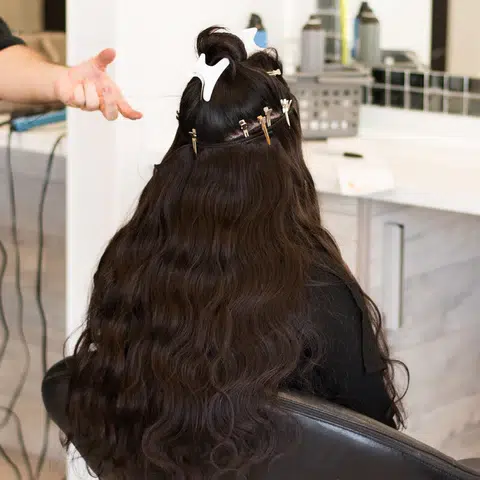
Nighttime Routine for Beaded Extensions
Let’s break down what you should train your clients to do every night.
1. Never Sleep With Wet Hair
This is non-negotiable.
When hair is wet:
The cuticle is open and vulnerable
The roots swell and create friction around the beads
Hair mats faster, especially where natural and extension hair blend
Professional advice:
If clients must wash at night, they should use a microfiber towel to gently blot excess moisture and then blow-dry from the root downward, focusing on the beads. The hair should be 100% dry, especially at the connection points.
Tip for stylists:
Mention this in every install. Remind them that sleeping with wet extensions will almost always lead to slippage and tangling.
2. Gentle Detangling Is Key
Clients should use an extension-friendly brush—preferably a loop brush or soft paddle brush—and start detangling from the ends upward.
Have them brush in sections:
Bottom layer
Mid-lengths
Top section
They should never tug or rip through knots. If the hair is dry, they can mist a light leave-in conditioner through the mid-lengths to soften it before brushing.
Extension tip:
Avoid oil-based products near the beads. Oils can weaken the bead grip and cause sliding.
3. Secure in a Loose Protective Style
Sleeping with loose hair allows friction between the pillow and scalp. Instead, recommend one of the following nighttime styles:
Loose 3-strand braid: Best for long or thick hair. Keeps strands aligned and protected.
Low ponytail with a silk scrunchie: Reduces tangles and prevents pulling.
Two loose braids (pigtails): Great for heavy installs—distributes weight more evenly.
Pineapple bun (for curly/textured hair): Keeps curls defined and prevents knotting.
Important:
Never recommend tight ponytails, high buns, or anything that adds tension at the bead row. This is one of the fastest ways to cause scalp pain and tension alopecia.
4. Use a Silk or Satin Pillowcase / Bonnet
This may sound simple, but the difference between cotton and silk is massive.
Cotton pillowcases:
Absorb moisture from the hair
Cause friction between the pillow and beads
Accelerate frizz, tangles, and breakage
Silk or satin:
Prevent moisture loss
Allow the hair to glide smoothly
Reduce stress on the beads and natural roots
Retail tip for salons:
Offer a branded silk bonnet or pillowcase as part of your aftercare package. It’s a high-value, low-cost upsell.

Salon Pro Tips: Set Clients Up for Success
Create a Client Sleep Care Kit
Put together a small retail bundle that includes:
Loop brush or extension-friendly comb
Silk pillowcase or bonnet
Lightweight leave-in conditioner or nighttime spray
Satin scrunchie
Label it as an “Extension Aftercare Set” and upsell it at checkout. It’s a win for both client results and your bottom line.
Educate From Day One
Every time you install beaded extensions, take 5 minutes before the client leaves to show them:
How to brush their hair (demo it)
How to braid or tie it for sleep
What tools to use and avoid
What happens if they neglect sleep care
The more educated they are, the fewer problems they’ll bring back into the salon.
Schedule Follow-Ups
After 1-2 weeks, follow up with your client and ask how their extensions are feeling—especially during sleep. If there’s discomfort or matting, it’s better to catch it early and make adjustments.
What Happens If You Don’t Follow Sleep Care?
Even the best hair will underperform if sleep habits are bad.
Here’s what clients risk if they skip these steps:
Neglect Problem Caused
Sleeping wet Matting, mildew smell, bead slippage
No braid/ponytail Tangles and frizz
Cotton pillowcase Dryness and friction damage
Rough brushing Extension breakage, bead loss
Tight styles overnight Scalp tension and traction alopecia

FAQ – Sleeping with Beaded Extensions
Q: Can you sleep with beaded extensions wet?
A: No. This is one of the biggest mistakes. Wet hair expands and is more fragile, increasing the risk of slippage, matting, and scalp irritation. Always dry the roots and beads completely before bed.
Q: Do beaded extensions hurt when sleeping?
A:Mild tenderness is normal for 1–3 nights after a fresh install, especially if the beads are close to the scalp. But ongoing pain isn’t normal. If your client complains of discomfort, check for:
Beads installed too tight
Improper positioning
Sleeping without protective styling
Q: Can you sleep with your hair down if you have beaded extensions?
A: Technically yes, but it’s not recommended. Sleeping with the hair down increases friction, leading to tangles and wear. A low braid or loose ponytail protects the hair and keeps it aligned with natural strands.
Q: What kind of pillowcase is best for beaded extensions?
A: A silk or satin pillowcase is ideal. It minimizes friction, helps retain moisture, and reduces pressure on beads. Cotton should be avoided due to its drying and abrasive properties.
Q: How should you sleep with curly beaded extensions?
A: Use the “pineapple” method or two-strand twists with a satin bonnet. This protects curl definition and reduces tangles while sleeping. Avoid cotton pillowcases and always apply a curl-safe leave-in mist before bedtime.
Q: What if my client is a restless sleeper?
A: Restless sleepers benefit most from a silk bonnet or scarf in addition to a braid or low ponytail. A satin pillowcase is a backup if the bonnet falls off during the night.
✅ Final Thoughts
Beaded extensions offer incredible versatility and durability—but only if they’re maintained properly.
Sleep care is one of the most overlooked but most important parts of extension aftercare. Teaching clients how to sleep with their beaded extensions will:
Prolong the life of their install
Reduce tangling and discomfort
Protect your professional work
Boost their satisfaction (and referrals)
Make sleep care part of your standard consultation and install process. When clients wake up happy, they stay loyal to your brand.

